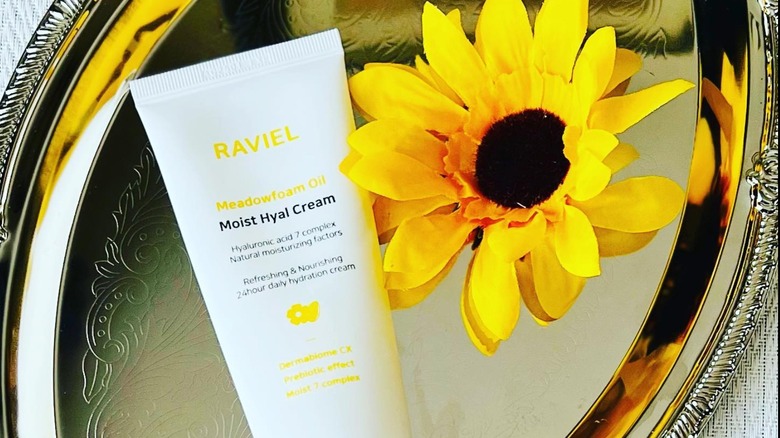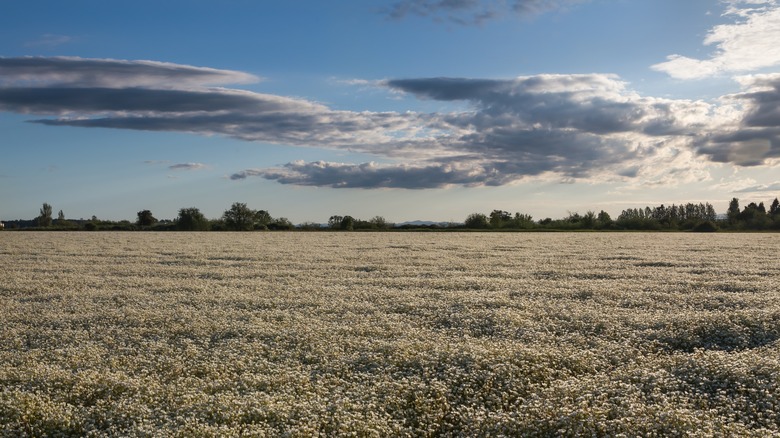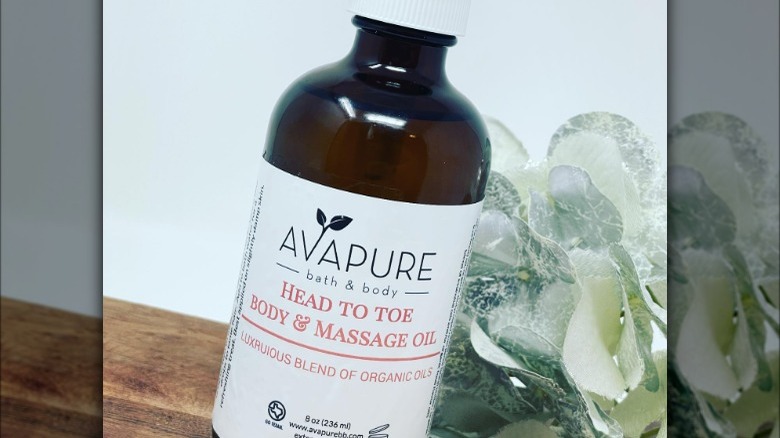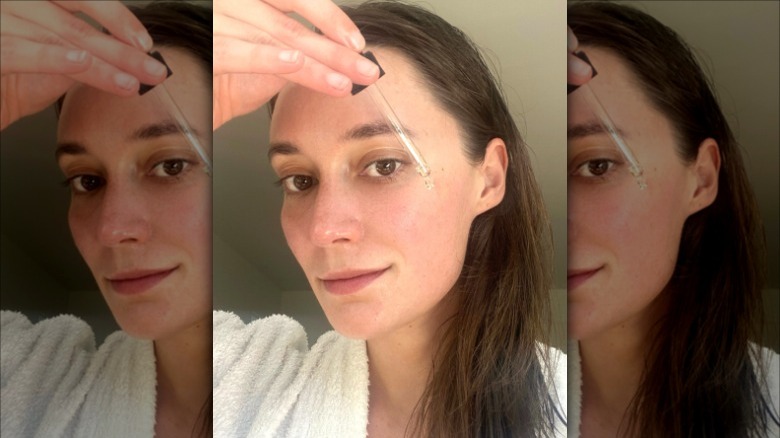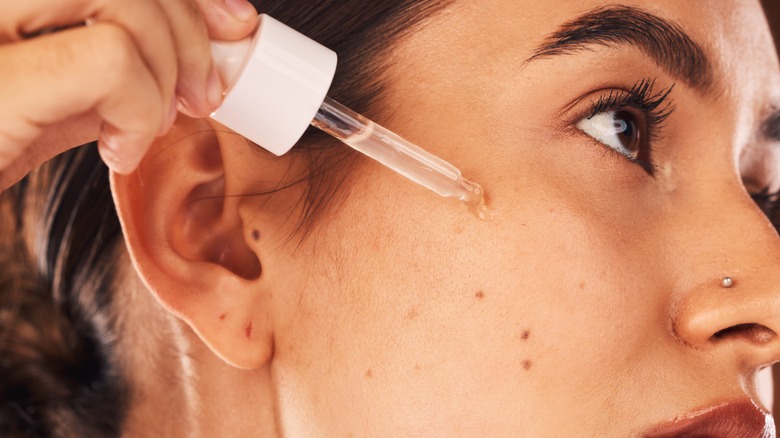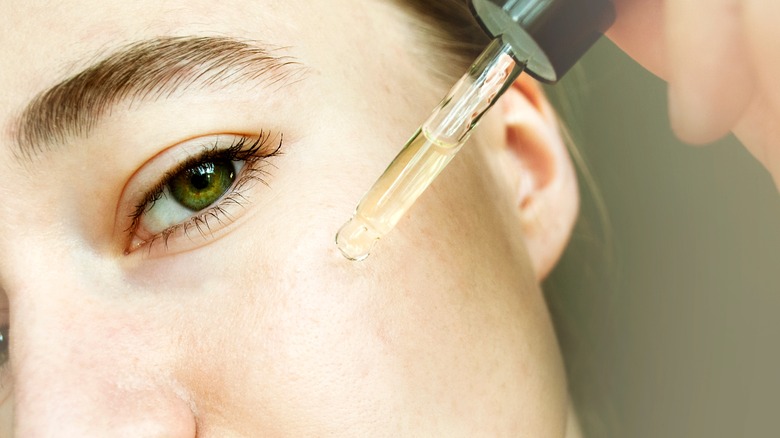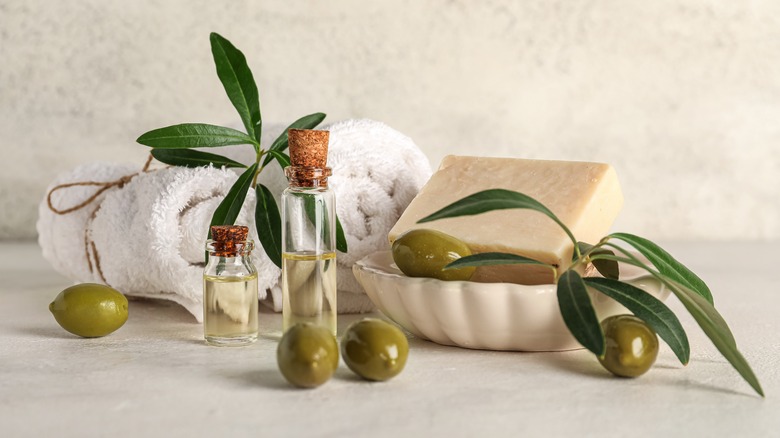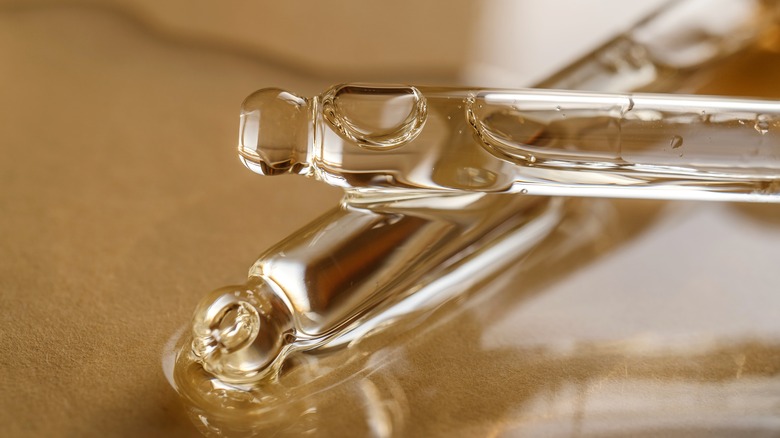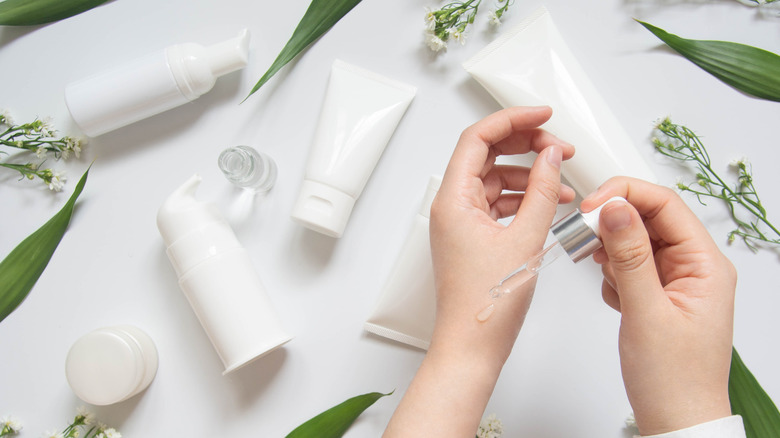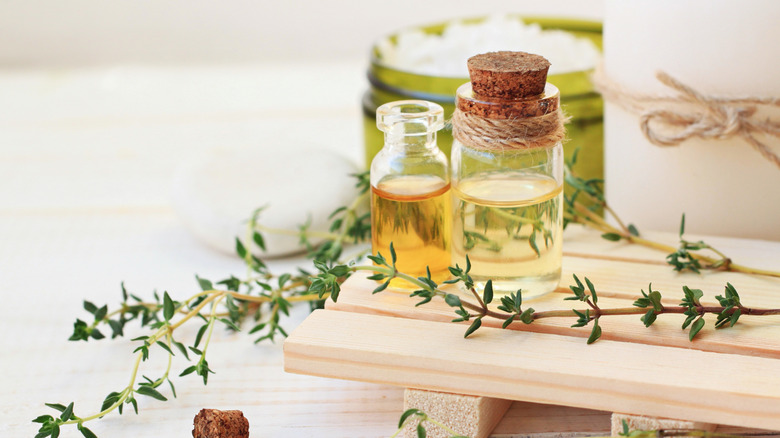Meadowfoam Seed Oil: A Crash Course Before You Add It To Your Skincare Routine
It wouldn't be surprising if you haven't yet incorporated meadowfoam seed oil into your self-care routine. Although it isn't exactly a beauty insider's secret, it does seem like one. Meadowfoam seed oil occupies a comparatively tiny niche within the $49 billion per year beauty industry. The total market for meadowfoam seed oil as a raw ingredient is only around $2 million per year, according to researchers at Oregon State University. Self-care product manufacturers are the primary buyers of this raw ingredient, although there are other possible uses for it.
Meadowfoam seed oil's apparent secrecy might also be, in part, because of the rarity of the fatty acids contained in it. Staff at the German laboratory Cosmacon explain that "this oil has a very unusual and rare fatty acid spectrum: It consists of about 95 percent fatty acids containing 20 or more carbon atoms."
Considering meadowfoam seed oil's relative newness as a seed oil crop, clinical researchers have not studied this oil and its components as extensively as they have studied some other oils. We still have much to learn about the possible benefits and downsides this ingredient offers. Now, let's discuss what we do know about meadowfoam seed oil.
What is meadowfoam seed oil?
"Meadowfoam" is a catch-all name that can refer to multiple species of annual flowering plants from the Limnanthes genus. The Smithsonian's Encyclopedia of Life alerts us to the existence of eight different meadowfoam species. Many of these are wildflowers. However, some meadowfoam flowers are now being bred and commercially cultivated for the oil that comes from their seeds. Researchers at Oregon State University (OSU) take credit for having developed and released eight meadowfoam varieties.
United States-based seed oil crop growers are only broadly cultivating two North American subspecies that are popular for use in skincare products. "The two subspecies used in agriculture are Limnanthes alba spp. alba and Limnanthes alba spp. Versicolor," according to OSU.
Ultimately, meadowfoam seed oil is the oil that's extracted and refined from the seeds of these two specific, commercially-grown subspecies of meadowfoam flowers that are native to North America. The extracted, refined meadowfoam seed oil stands alone as an ingredient that you can apply directly to your skin. It can also be used along with other ingredients in various formulations to create a variety of nourishing skincare products.
How the seeds from meadowfoam flowers become skincare products
Now, let's see how these flowers become oil. Susan M. Parker, author of the book "Power of the Seed: Your Guide to Oils for Health & Beauty," interviewed Jim Daniels from Natural Plant Products (NPP), an organization that works with meadowfoam seed oil growers to implement the sales, distribution, formulation, and marketing of the oil. From this interview, we learn that there are three different possibilities for how the oil is extracted and refined from the meadowfoam flower seeds: solvent extraction, expeller pressing, and cold processing. Parker goes on to explain that the "cold processed oil ... is the most costly but the closest to a pure product."
New Directions Aromatics, a wholesaler of cosmetic ingredients, explains that the meadowfoam seeds have an outer shell that must first be removed. Then, the seeds are cleaned, ground up, and subjected to intense pressure in a press. This forces the oil to come out.
In the end, beauty product manufacturers have the option to select meadowfoam seed oils created using any of the three processes. This decision has a direct effect on their finished product. Parker explains that the cheapest meadowfoam seed oil skincare products result from the use of the solvent-extracted oil.
The history of meadowfoam seed oil
In the relatively recent past, meadowfoam has been transformed from its historical status as a humble wildflower. This transformation was initiated when U.S. Department of Agriculture (USDA) researchers decided to investigate meadowfoam to see if these flowers could provide new raw materials for American manufacturers to use.
More than a couple of decades elapsed as the researchers took the development of this new crop from idea to implementation. The earliest stages of USDA testing occurred in the latter part of the 1950s. Research continued into the 1960s, according to the Oregon Meadowfoam Growers Association (OMG), which is a cooperative of 50+ farms currently growing the flowers that become the skincare oil. The USDA teamed up with people from Oregon State University (OSU) and others to conduct trials and breed meadowfoam varieties that would be worth cultivating by American farmers. It wasn't until 1983 that the oilseed crop was ready for commercial production.
Meadowfoam seed oil fatty acid profile
According to the staff at Oregon State University's Micronutrient Information Center, essential fatty acids are a necessity if you want to have problem-free, glowing, healthy skin. You can either eat the essential fatty acids or rub them onto your skin and allow them to be absorbed. Either way, your body can assimilate the nutrients they have to offer you.
When you're attempting to better understand a particular oil's characteristics and benefits, it's worth evaluating which fatty acids are present in the oil. There's a formal method of doing this evaluation. Joseph Zalusky at Seedworld.com offers technical insights about the testing method people are using to understand the exact composition of the substances they're working with. They use a high-throughput gas chromatograph to perform the analysis. Zalusky explains that "fatty acid profiling, technically described as analysis of fatty acid methyl esters (FAME), is also used by plant breeders and producers to determine oil composition of oil and oil seeds."
According to Cosmacon, meadowfoam seed oil is made up of approximately 63% eicosenoic acid, 17% docosadienoic acid,16% docosenoic acid, less than 2% oleic acid, and less than 2% linoleic acid. In a paper entitled Growing Meadowfoam in the Willamette Valley, researchers from Oregon State University offer additional insight, explaining, "Unlike common seed oils, meadowfoam oil consists almost entirely of long-chain fatty acids (more than 18 carbons)."
Meadowfoam seed oil's moisturizing properties
If you're hoping to find a natural skincare ingredient that will moisturize and hydrate your skin, meadowfoam seed oil is worth considering. According to Newdirectionsaromatics.com, "Antioxidants and fatty acids are the stars of Meadowfoam seed oil that make it a feast for the skin and hair, endowing it with rich moisturizing properties and a luxurious texture."
It's ideal to use meadowfoam seed oil frequently if you want to maximize this ingredient's moisturizing potential. Initial research published in Clinical, Cosmetic, and Investigative Dermatology suggests that repeated topical applications of oil are able to help with the rehydration of skin after it has been subjected to a chilly, air-conditioned environment. The subjects of the trial had a mixture of oils including meadowfoam seed oil plus macadamia nut oil, shea butter, and moringa applied to the skin on their forearms two times each day for the 14-day period while the research was in progress. In this short period of time, the researchers were able to make a determination that these plant-based natural oils seem to be ideal to use for formulating skin moisturizers.
Meadowfoam seed oil and acne
People with acne have a different set of skincare considerations than everyone else does; they need to be especially proactive about avoiding the use of cosmetic ingredients that can cause pimples, cysts, and other lesions. Acne-prone skin is particularly susceptible to clogged pores. These clogged pores create either whiteheads or blackheads depending on if they stay under the skin's surface (the former) or move upward and display more topically (the latter).
Perhaps you're wondering, "Is meadowfoam seed oil a comedogenic or a non-comedogenic skincare option?" Good news: According to New Directions Aromatics, it's the latter. People with ordinary acne can safely use it. This advice doesn't apply to people with fungal acne, however, as COSRX advises people with fungal acne to avoid using certain cosmetic ingredients. After all, fungi are fueled by oils, so it's advisable for people with fungal acne to steer clear of applying meadowfoam seed oil to vulnerable areas of the skin including the face, chest, neck, and back.
Ideas for incorporating this oil into your skincare routine
Your skincare routine probably varies a bit from everyone else's. Your regiment has no doubt been influenced by considerations such as your skin type, budget, and preferences, but whatever steps your skincare routine normally encompasses, you can integrate meadowfoam seed oil into your usual daily self-care process.
If you usually stick to using a minimalist skincare routine, perhaps you typically get started by washing your face with a cleanser, applying a serum, next adding some moisturizer, and then following up with sunscreen. If your skin has a tendency to be on the oily side, you could use meadowfoam seed oil as a replacement for the moisturizer you've been using.
However, if your skin has more of a tendency to be dry, you might decide to continue putting on your usual moisturizer and then apply a few drops of meadowfoam seed oil to your face afterward. Or, you could mix a few drops of meadowfoam seed oil into your moisturizer before you apply it. Another option: Seek out a different moisturizer that includes meadowfoam seed oil as an ingredient. Or you could blend meadowfoam seed oil with macadamia nut oil, shea butter, or moringa oil for a combination that is already known to be an effective moisturizer. You can also dispense meadowfoam seed oil onto your skin to revitalize any rough, chapped areas you might have, including on your lips, hands, elbows, or feet.
Meadowfoam seed oil shelf life
Per Natural Plant Products, this oil has a long shelf life. It can potentially last as long as three years under the right conditions. According to research published in Industrial Crops and Products, meadowfoam oil extracted from the Limnanthes alba flower species was the most stable of all the vegetable oils the researchers investigated. Furthermore, they made an additional interesting discovery: When they mixed meadowfoam oil with other oils such as jojoba oil and castor oil, they were able to improve the oxidative stability of the other oils.
In case you're wondering what, exactly, oxidative stability is, the Glosbe Dictionary defines it as being "a measure of oil or fat resistance to oxidation." The main takeaway is that, in some cases, meadowfoam oil apparently has the potential to improve the shelf life of cosmetic formulations when it is included. Bottom line, if it's a high priority for you to buy skincare products that last a long time, you'll definitely want to consider using products that contain meadowfoam seed oil as a significant ingredient.
Meadowfoam seed oil vs. olive oil
Olive oil and meadowfoam seed oil are both useful ingredients to consider adding to your skincare routine. Both are fantastic moisturizers. The main differentiators between these oils are the unsaturated fatty acids in their profiles, according to research published in the Journal of Spectroscopy. In particular, extra virgin olive oil is richer in oleic acid than meadowfoam seed oil. These researchers also alert us to the fact that extra virgin olive oil is likely to be less shelf stable than meadowfoam seed oil due to extra virgin olive oil's higher α-linolenic acid content.
One other important consideration is that we don't recommend using olive oil on acne-prone skin unless you get the go-ahead from your dermatologist first. While, for some people, olive oil is the skincare product they're missing, others might be far better off with meadowfoam seed oil — or even jojoba oil.
Meadowfoam seed oil vs. jojoba oil
Meadowfoam seed oil has many things in common with jojoba oil but also some key differences. The primary differentiator between these oils is their chemical composition. Meadowfoam seed oil is truly oil. In contrast, according to an abstract by G. K. Sandha and V.K. Swami, it's fatty alcohol esters rather than oils that make up the most important components in jojoba oil (via ResearchGate). Despite jojoba oil's name, chemists actually consider it to be a wax. However, like meadowfoam seed oil, jojoba oil has a high concentration of the fatty acid known as eicosenoic acid, according to research in the journal Medicina (Kaunas). As a result, both oils offer exceptional moisturizing and hydrating properties.
Both oils tend to be appealing for their oxidative stability, but, according to the staff at the Oregon Meadowfoam Growers Association, meadowfoam seed oil is substantially more shelf stable than jojoba oil. In fact, a study published in Industrial Crops and Products notes that it's possible to dramatically improve jojoba oil's shelf life by adding 10% meadowfoam oil to it.
Both oils are edible, but the human body is able to metabolize meadowfoam seed oil. However, jojoba oil cannot be digested. It passes through the human body undigested, possibly causing problems and discomfort in the process. Important takeaway: Having a curious toddler who might eat your skincare products is one point in meadowfoam seed oil's favor.
Does meadowfoam seed oil trigger allergies?
Research published in the International Journal of Toxicology indicates that meadowfoam seed oil is a non-toxic ingredient that can safely be used for cosmetic purposes. Moreover, few people reported having allergic reactions to the oils they studied. That said, the research mentions the possibility that some individuals may experience allergic reactions to the oil. Because adverse reactions could happen, we always recommend implementing a patch test with new skincare products and ingredients before you spread them over large a surface area of your face or body.
Beyond that, we don't have extensive clinical research providing insights about whether high levels of exposure to meadowfoam seed oil's most significant fatty acids could be expected to trigger allergies. What we do know is that oleic acid, which is in the oil in a very small quantity, isn't known to have allergenic properties, according to research published in the Occupational Toxicants.
Be aware that it is possible to buy beauty care products where meadowfoam seed oil has been combined with other ingredients that could cause allergic reactions. Research published in the Science Immunology journal alerts us that certain common ingredients like benzyl benzoate and benzyl cinnamate are likely to cause allergic contact dermatitis. It's not unusual to find these ingredients combined with meadowfoam seed oil in commercially available self-care products.
How socially responsible is meadowfoam seed oil?
Wondering how meadowfoam seed oil rates in the social responsibility department? In 2019, Natural Plant Products was awarded an attestation of conformity — raw materials — for natural and organic cosmetics from Ecocert, a third-party certifying body. According to the Ecocert website, this certification guarantees "environmentally friendly production and processing processes respecting also human health." At the time of writing, NPP was promoting its Meadowfoam Seed Oil XPR product as being Ecocert certified.
To clarify, however, United States-grown meadowfoam seed oil is not currently available with organic certification, according to Susan M. Parker. She explains, "The movable nature of the fields where meadowfoam flowers produce seeds each season make organic certification nearly impossible. But the growing practices used by the farmer's co-op are sustainable and ecologically sound."
Still, meadowfoam seed oil is vegan-friendly, as it's an entirely plant-based ingredient. Vegans and vegetarians can use the unaltered meadowfoam seed oil without reservations. However, be aware that the vegan claim does not automatically apply to all cosmetic formulations made with meadowfoam seed oil because those could possibly contain animal-derived ingredients such as lanolin or beeswax. Vegans will want to remain vigilant when considering a purchase of any meadowfoam seed oil product that includes additional ingredients. It's always prudent to read the product labels so you know what you're getting. Now, with this knowledge in mind, you can use pure meadowfoam seed oil or find it in moisturizers, lip products, eye creams, and more with confidence.
